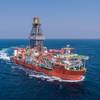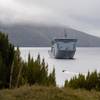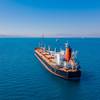MARCO Delivers First of Two 104-ft. Boats for SF Bar Pilots
“At that late date we realized that the keel coolers that we specified and purchased were not adequate to cool the diesel generators. After we had already purchased the generator sets and the keel coolers, the diesel engines’ specifications, including heat rejection, were changed by their manufacturer,” says Bob McMahon, Marco Shipyard’s vice president and general manager at Marco Seattle.
McMahon contacted Duramax Marine, the manufacturer of the new DuraCooler keel coolers used on the pilot boats. A few days later Marco had new keel coolers with special, extra-long nozzles to give the coolers more stand-off from the hull and extra tubes for more cooling capacity.
According to a Duramax Marine representative, the company was able to recommend a fix because of its ongoing, full-scale testing program. If the company had not instilled this specialized testing, it would not have known how much the additional stand-off distance would increase heat transfer. Since the DuraCoolers were tested under different stand-off distances and under various internal and external conditions, Duramax was able to remedy Marco’s time-sensitive situation.
The second vessel is scheduled for trials the end of March, and both boast Lo-Rez soft mount system for twin propulsion engines. The Lo-Rez system utilizes six BR4-TLS steel-spring islolators and a 25-RT flexible coupling for each of the four engines.
The vessels, which will replace existing 85 ft. vessels, will transfer pilots safely to and from ships entering or leaving San Francisco Bay, and provide quarters for the pilots between assignments.
At the stern, the vessel carries a 16 ft. Ocean Tech RIB powered by a 100-hp diesel engine driving a waterjet, which can be used as an emergency rescue boat and for pilot transfers with low-freeboard vessels. Constructed completely of steel, the twin-screw San Francisco has a beam of 30 ft. and a depth of 13 ft. A pair of diesel engines provides a combined 2,200 hp to drive the vessels 64-in. diameter Sound Propeller Ni-Al-Bronze props through Twin Disc gear boxes.
Harris Electric provided distribution panels, a master alarm panel, wiring and electronics, which include two Furuno X-band radars, GPS receivers, color depth sounder; Transas chart plotting system with Ocean PC hardware; and four SEA VHF radios.










